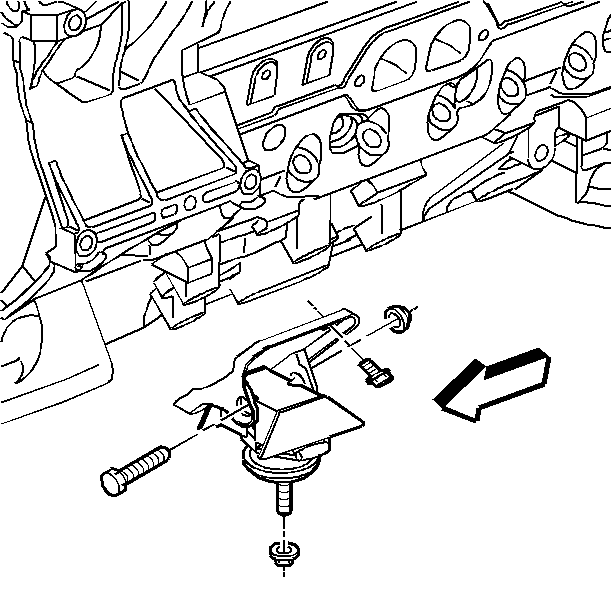Removal Procedure
- Inspect the engine mounts for the following problems:
- Raise and support the vehicle. Refer to SECTION 0A.
- Disconnect the catalytic converters from the exhaust manifolds.
- Remove the engine mount nuts to both sides of the engine.
- Raise the engine so that the engine mount studs will clear the crossmember.
- Remove the engine mount through-bolt and nut.
- Remove the engine mounts.
- If necessary, remove the heat shield.
- If necessary, remove the engine mount spacers.
- Remove the engine bracket bolts.
- Remove the engine bracket.
Important: Before you replace any engine mount due to fluid loss, ensure that the fluid is leaking from the engine mount and not from the engine or accessories.
| • | Damage to the rubber portions of the mount |
| • | Fluid loss |
| • | Damage to the mounting stud |

Notice: When raising or supporting the engine for any reason, do not use a jack under the oil pan, any sheet metal, or the crankshaft pulley. Due to the small clearance between the oil pan and the oil pump screen, jacking against the oil pan may cause the pan to be bent against the pump screen. This will result in a damaged oil pickup unit.

Installation Procedure
- Install the engine bracket.
- Install the engine bracket bolts.
- Install the engine mounts.
- Install the engine mount heat shield.
- Install the engine mount spacers, if used.
- Install the engine mount through-bolt.
- Lower the engine.
- Install the engine mount nuts to both sides of the engine.
- Connect the catalytic converters to the exhaust manifolds.
- Lower the vehicle.

Tighten
Tighten the engine bracket bolts to 56 N·m (41 lb ft).
Notice: Use the correct fastener in the correct location. Replacement fasteners must be the correct part number for that application. Fasteners requiring replacement or fasteners requiring the use of thread locking compound or sealant are identified in the service procedure. Do not use paints, lubricants, or corrosion inhibitors on fasteners or fastener joint surfaces unless specified. These coatings affect fastener torque and joint clamping force and may damage the fastener. Use the correct tightening sequence and specifications when installing fasteners in order to avoid damage to parts and systems.

Tighten
Tighten the engine mount through-bolt to 105 N·m (77 lb ft).
Tighten
Tighten the engine mount nuts to 54 N·m (40 lb ft).
Tighten
Tighten the converter-to-exhaust manifold nuts to 21 N·m
(15 lb ft).
